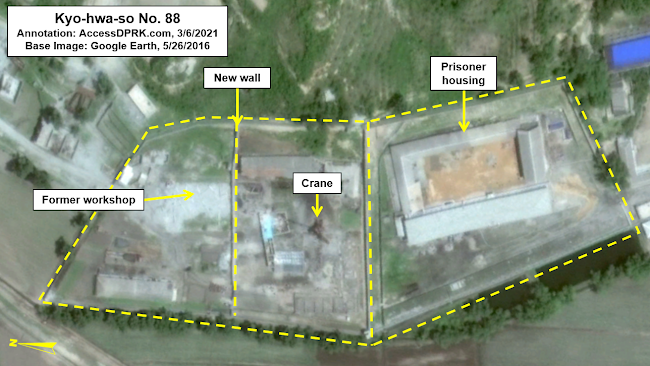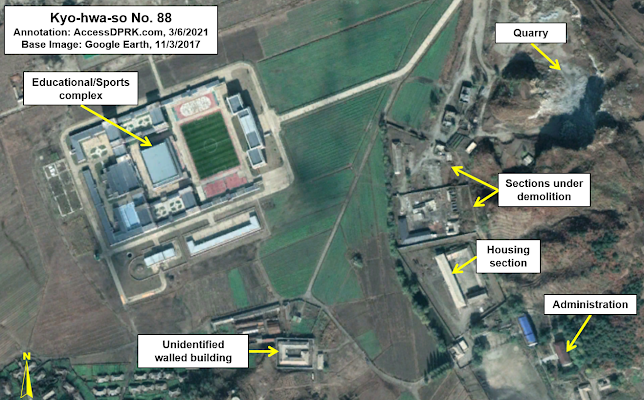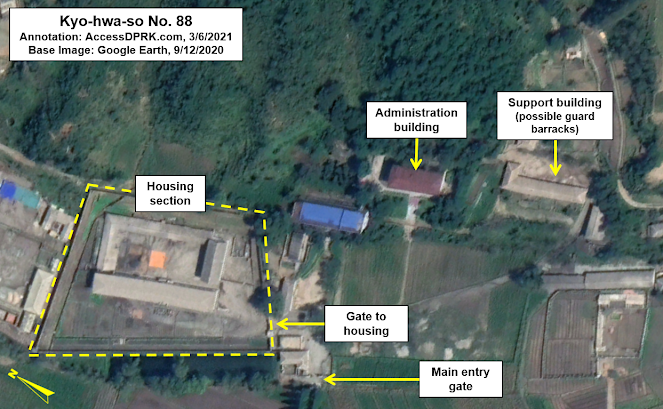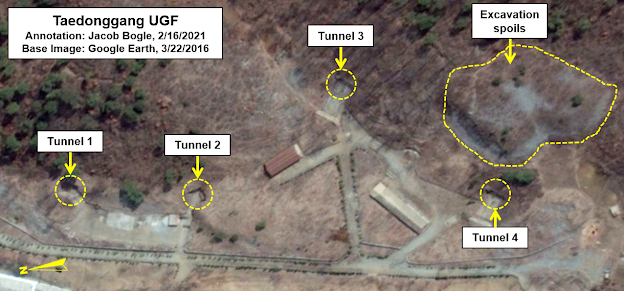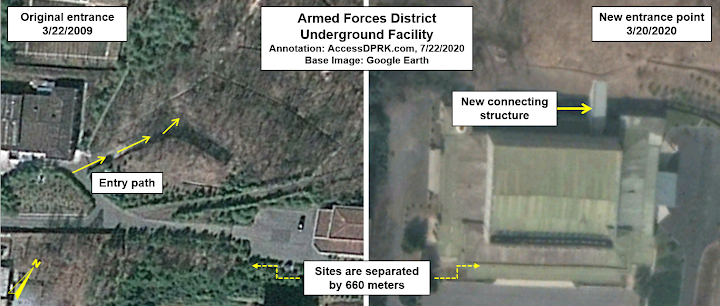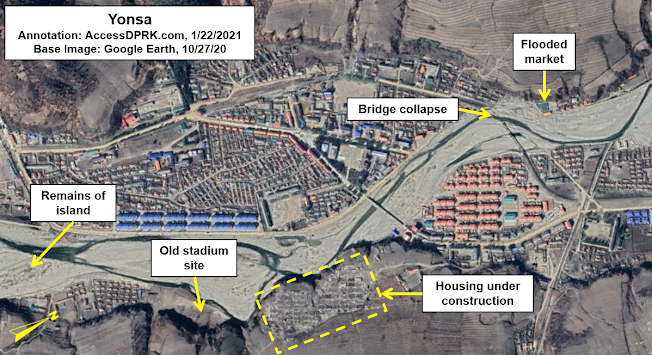North Korea is more than nuclear weapons and it's more than the caricature of a fat dictator and robotic people with no real lives. Their lives are also more than the often scripted and saccharine scenes shown in official media - as though the people are then placed in a box and vanish until needed again.
North Korea is a dynamic country with 25 million unique human beings. Yes, it is a totalitarian state with a terrible human rights record, but those 25 million people still work every day to live their life, go to work and to the markets, go to school, and do the things we all do in pursuit of the opportunities available.
Especially since the country has become even more closed off due to COVID-19, it can be difficult to see examples of everyday life in North Korea. However, satellite imagery gives us the ability to observe a myriad of activities across the nation that would normally be off-limits to tourists or are currently not within reach.
Play Ball!
Like the rest of the non-US-centric world, football means soccer in North Korea, and it's a fairly popular game. The national team has qualified for multiple FIFA World Cup, Asian Games, AFC Asian Cup, AFC Challenge Cup, East Asia Cup, and Dynasty Cup competitions. They've won a total of 138 games including a Gold Medal at the 1978 Asian Games.
As a result, every county seat has a stadium and many grade schools, universities, and military bases have soccer fields. Pyongyang has an enormous athletics infrastructure with at least 58 stadiums and dedicated soccer fields.
In the important military town of Sinpo, a soccer game can be seen underway on this image dated May 7, 2016. I estimate that there's at least 1,500 spectators.
Museum Trip
The Susan-ri House of Class Education is a special type of museum in North Korea that chronicles alleged human rights abuses and war crimes by the United States during the Korean War and acts as an indoctrination vehicle for anti-US/ROK ideology.
Although the purpose of the museum is unique to North Korea, it's still similar to other museums around the world where school classes are taken on trips as well as worker's union groups and others, making these museums part of the normal life experience for the people.
This specific museum was one of the first to be rebuilt and modernized in 2010; a process that continues nationally to this day. On Jan. 14, 2015, a large crowd can be seen waiting to go inside the museum and explore the museum grounds (which includes an alleged mass grave of "victims" of American atrocities). A number of buses are also visible in the parking lot.
There may or may not be a connection, but on Jan. 10, 2015, North Korea offered to suspend nuclear testing in return for the US and South Korea not holding their annual joint-military drills. The offer was rejected. So, the regime may have decided to increase the amount of anti-US propaganda as a result, including ramping up visits to the museum. (Mere speculation on my part.)
Kim & Friends Visit Palace
The main way to travel from Pyongyang to the palace is via a massive, green train. The use of an armored train dates back to Kim Il Sung and it has become to primary mode of transportation for each generation of Kim as it is basically an "Air Force One" on tracks.
Tracking down the train's movements via commercial satellite imagery became one way to dispel rumors of Kim Jong Un's alleged death in April 2020 after he went missing for a few weeks. 38 North managed to find the train at the Wonsan Palace on two occasions around this time, and imagery obtained by others showed at least one of Kim's pleasure boats out on the water. While this didn't confirm Kim was alive, it was part of a growing body of evidence that he was indeed alive and at the palace, even if in bad health.
He eventually reappeared in public on May 1 at the opening of the Sunchon Fertilizer Plant.
Monumental Missile
2017 was a banner year for North Korea's missile program as they successfully tested their Pukkuksong-2 medium-range intercontinental ballistic missile, and Hwasong-12 & Hwasong-15 intercontinental ballistic missiles. The Nov. 28th Hwasong-15 test revealed that it could theoretically reach all of the United States.
As a result, the regime erected monuments at several of the launch sites. The largest of the monuments was dedicated to the Nov. 28th test of the Hwasong-15. The monument includes the concrete launch pad (right side) and a stone monument (left) giving a description of the test, its importance, and the fact that it was personally overseen by Kim Jong Un. It also has a parking area across the road.
In this image from August 31, 2018, a crowd of people can be seen walking from the launch pad to the stone monument. Visiting monuments and historic sites on special holidays or as part of "field trips" (for both kids and adults) is an everyday kind of thing in the DPRK.
Dredging for Gold
Most of the rivers in North Korea are not navigable. The upper reaches of the Kuryong River is no different. For many years dredging has been going on in the river. Since the river isn't navigable in the first place, the dredging isn't to improve shipping navigation.
However, along this portion of river is the Unsan Gold Mine. In operation since at least 1895, the mine has been one of Korea's (and later North Korea's) major sources of gold.
Gold is heavy and gets eroded out of the original mineral deposits and eventually washed down river, where it's deposited in the riverbed and along the riverbanks. In the early 1990s, the country was mining around 4 tonnes of alluvial gold - gold found in riverbeds and other sediment. At today's gold prices, 4 tonnes is worth $227.6 million.
How much gold currently comes from the Kuryong riverbed is unknown, but continuous signs of dredging operations (with multiple dredges) can be tracked for 40 km and began ca. 2003.
Unfortunately, there are several down-sides to this type of mining. For one, it destroys the habitats in the immediate area. Secondly, the process creates a lot of particulate pollution, as the sand and silt is disturbed and flows downstream. This can cause lower amounts of oxygen in the water and kill most species (including the amphibians that live along the banks).
Finally, depending on the method used, once the gold-bearing material is gathered, the process to extract the pure gold can involve using mercury and other chemicals that leak into water systems and can cause severe health problems for the miners.
Plane Overhead
At any given time, there are up to 5,000 planes flying around the world. This makes finding a plane in flight on Google Earth something that isn't common, but not exactly rare. Back in 2005 there was even a GE user who put together a KMZ with 75 examples of planes in flight. I've found a few dozen more over the years.
North Korea is a different story. Prior to COVID-19, there were only a few dozen non-military flights a month into, out of, and within the country. And even military training flights are restricted due to a lack of aviation fuel. With COVID-19, there might be just one or two flights a month to shuttle VIPs around.
So this little find is far more unusual than finding planes coming into London or Beijing.
This particular An-2 is flying around the Kuktong Airfield, which happens to house two An-2 squadrons, and is also just 21 km away from the Orang Airbase, home to the 8th Air Training Division.
Coniferous Gas
To help bridge this gap, mostly in rural areas, North Korea has converted many of its trucks and tractors to run off wood gas, a fuel made by burning wood or charcoal at relatively low temperatures and then processing the material onboard to produce fuel the vehicle can run on.
Unfortunately, while wood gasification allows thousands of trucks, tractors, and even motorcycles to operate in the country, the process and equipment used in North Korea is very dirty and inefficient.
The gasifiers send out large plumes of thick smoke. Only a small amount of fuel can be produced at any given time, so if it breaks down, the vehicle will stop running. And, it requires drivers to practically be mechanics to operate and maintain the equipment, especially as most of the vehicles on North Korea's roadways are already decades old and require their own maintenance.
Waiting on the River Ferry
While most transportation is carried out by trucks, buses, and trains, North Korea does have a few river crossings that are serviced by passenger & cargo ferries.
Unlike the large ferries that can carry people and cars to their destinations around New York Harbor, these ferries can only carry one or two dozen people along with small amounts of cargo. This ferry on the Changja River is important because the nearest bridge crossing is 10 km away (making it a 20 km journey to the other side of the river by car, and then 20 km back).
For a population with limited car ownership and bad roads, ferry crossings become an important piece of daily life for many in rural areas.
Kim Il Sung's Birthday
In the city of Kaechon, the above image shows people doing traditional folk dances in preparation for Kim Il Sung's 107th birthday on April 15. Kim's birthday is known as the "Day of the Sun" and it is one of, if not the most important national holidays in North Korea.
People are given time off work and school, the state gives small gifts to the population, and people are required to visit important local monuments dedicated to Kim Il Sung, and to take part in "spontaneous" celebrations.
While these celebrations are, of course, planned and practiced for, people receive an additional two days off after the main holiday date, and so get to have some relaxation and family time.
Having mass birthday celebrations for a man who died a generation ago may seem odd to most, but the importance of the holiday is considered the North Korean equivalent of Christmas in importance. (Note: the actual holiday of Christmas is not observed in North Korea. Instead, the winter solstice is celebrated on Dec. 20 and the birthday of Kim Jong Il's mother is celebrated on Dec. 24.)
Going to Class
Collective Agriculture
While there are farmers and other agricultural workers, due to the country's lack of equipment, the vast majority of the population lends a hand (rather, they're drafted) to do farm work for certain periods of the year - namely, during planting and harvesting. Soldiers, students, and factory workers all work to ensure that the country can provide as much food as possible each season.
One very obvious example of this that can be seen via satellite is after certain crops have been harvested. In this case, corn. The harvested golden ears are then placed in open spaces to be dried by the sun.
How food is distributed in North Korea can get complicated. There's the regular state-owned cooperative farms. There's farms control by the military. And, there's smaller plots of land that factories and schools use to try to supplement their food supply or sell in the markets.
The result of that complicated network gives us this image: corn drying at the Kim Jong Il Postgraduate Military Institute.
NK News published an article detailing the corn drying operation at other sites around Pyongyang in 2020.
Pioneering Parades
North Korea is very well-known for its huge parades and mass events. While the media typically focuses on military parades, the country holds other types.
Being in a parade or other mass event may not be an everyday activity, but training for them and then participating in the main event is still common enough. These events can involve tens of thousands of people and can require over a month of training. This means that most citizens have taken part (as a "performer") in some form of mass gathering in their hometown or county seat at least once, and likely multiple times.
As part of the 10th Congress of the Kimilsungist-Kimjongilist Youth League (the country's main youth organization), participants threw a parade. Satellite imagery revealed preparations in March for the Youth League meeting in April.
Like all of these large parades, the participants used their bodies to spell out words, make shapes, and do other cool things reminiscent of marching band competitions.
On this March 9, 2021 image, participants are in the process of spelling out "pioneer". That is most likely a reference to the Young Pioneer Corps which is for children under the age of 15.
--Jacob Bogle, 4/20/2021

























